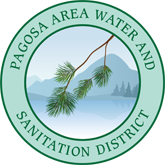Customer Care > FAQs
Frequently Asked Questions
Why do I pay Availability Fees on vacant property?
Once water and/or wastewater lines are available to within 100 feet of the property, by State Statute, the District is able to assess an Availability Fee. The monies collected can only be used to retire Municipal bonds sold by the District to finance major capital improvements. When the property is actually connected to the water and/or wastewater system, the Availability Fee is no longer charged and is replaced by the service charge.
If I am not using any water, why do I still pay a water bill?
Any time there is an existing water meter at a property, the minimum monthly service charge is assessed. These charges help defray the cost of reading meters, billing and maintenance of the water distribution system.
My water usage seems high! How could I use so much water?
Excess water usage can be attributed to a variety of factors such as leaky toilets or faucets. A leak 1/16th inch in diameter can waste approximately 24,667 gallons in a month! Outdoor watering can also use a tremendous amount of water. We highly recommend that all of our customers become registered users of our FREE leak alert system, Aquahawk. Water conservation and responsible landscaping materials are available at the District office and we would be happy to assist you!
What should I do if my water usage is too high and I think that I might have a leak?
If you suspect a leak, register with AquaHawk to view your usage. AquaHawk is our Automated Meter Reading Technology, which allows you and the District Office Staff to view your account history and recent use. A problem might be identified using AquaHawk. In addition, the District can offer further suggestions on how to narrow down the cause of a possible leak. Feel free to contact the office at 970-731-2691. Please note: District technicians will not enter your property to help determine the cause or location of the leak.
Where can I pay my bill?
The District offers automatic bank draft service and online payment options. Payments also can be brought to the District office at 100 Lyn Ave. during normal business hours. Lastly, payments may be made at either branch of TBK Bank as long as you have the payment stub portion of your billing statement.
How do I replat or combine lots?
Depending on jurisdiction, you would need to contact either the Town of Pagosa Springs (970-264-4151) or Archuleta County Planning Department (970-264-5851). Please provide the District with the recorded Resolution or Replat in order for your billing to be adjusted.
I am selling my property. How do I have my water and wastewater billings changed into the new owner’s name?
If you are closing the transaction through a title company, the District will automatically be notified after the transaction is recorded. The title company will take care of any pro-ration of your current charges between you and the buyers of your property. If the sale of your property is not being handled by a title company, you will need to bring the recorded deed into the District office.
How do I change my billing address?
Please fill out the online Contact Information Change Form. Alternatively, you can send a note with your payment, or fax us the information.
I am renting a house, how can I have the bill sent directly to my address as a tenant?
The owner of the property is always ultimately responsible for the water and/or wastewater bills, so their name must remain on the account. However with the owner’s permission, the bills can be sent to you directly. Property Owners can complete the Landlord/Tenant Agreement Form to have statements sent to their tenants.
What are the pH and the hardness of the water in the Pagosa Springs area?
The eastern or downtown area of Pagosa Springs is typically served by the Snowball Water Treatment Plant and the average pH is 8.6 and hardness is generally in the 1.92 grains/gallon or 33 milligrams/liter range. The western portion including the Pagosa Lakes area is typically served by the Hatcher and San Juan Water Treatment Plants. The San Juan Treatment Plant is used as a peaking plant only during months of high water use. The average pH is 8.2 and the hardness is generally in the 8.72 grains/gallon or 150 milligrams/liter range.

